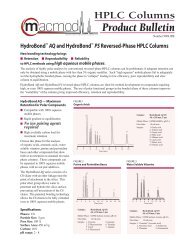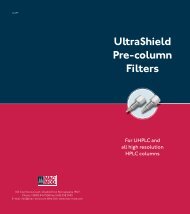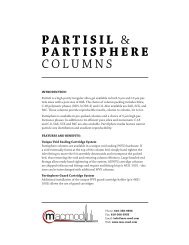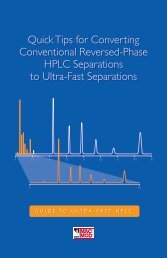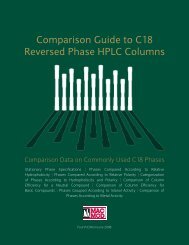HALO PFP - MAC-MOD Analytical Inc.
HALO PFP - MAC-MOD Analytical Inc.
HALO PFP - MAC-MOD Analytical Inc.
- No tags were found...
You also want an ePaper? Increase the reach of your titles
YUMPU automatically turns print PDFs into web optimized ePapers that Google loves.
<strong>HALO</strong> <strong>PFP</strong> uses proprietary bonding chemistry to achieve excellent stability andlong column life. The extremely low bleed characteristics of the <strong>HALO</strong> <strong>PFP</strong> phasemake it particularly well suited for LC/MS applications.As with all <strong>HALO</strong> phases, the combination of ultra-pure reagents, “Type B” silica,dense bonding technology, and optimized endcapping produce a base-deactivatedstationary phase that provides excellent peak shape for basic compounds.Mechanism of SeparationReversed phase separations on <strong>HALO</strong> <strong>PFP</strong> columns are primarily influenced byhydrogen bonding and dipole-dipole interactions. However, π–π interactions andmild hydrophobic binding interactions often contribute to retention and selectivity.In addition, the polar <strong>PFP</strong> group makes the <strong>HALO</strong> <strong>PFP</strong> phase a suitable choice forHILIC applications. (See Figure 1 for the structure of the <strong>PFP</strong> bonded phase.)Figure 1: Structure of <strong>HALO</strong> <strong>PFP</strong> bonded phaseFigure 2 illustrates the difference in selectivity offered by <strong>HALO</strong> <strong>PFP</strong> versus<strong>HALO</strong> C18. The improved separation of 1-phenylnaphthalene and pyrene on<strong>HALO</strong> <strong>PFP</strong> is due to π–π interactions. The stronger hydrophobic binding interactionon the <strong>HALO</strong> C18 is responsible for the longer retention of butylbenzene andfor the dramatic difference in selectivity represented by the change in elution orderbetween butylbenzene and acenaphthene on <strong>HALO</strong> C18 versus <strong>HALO</strong> <strong>PFP</strong>.Figure 2: <strong>HALO</strong> <strong>PFP</strong> offers an alternate selectivity to <strong>HALO</strong> C18TEST CONDITIONS:Column Dimensions: 4.6 x 50 mmMobile Phase: 30/70 water/methanolFlow Rate: 2.0 mL/min.Pressure: approximately 250 BarTemperature: 40 °CDetection: UV 254 nm, VWD<strong>HALO</strong> C18PEAK IDENTITIES:1. Butylbenzene2. Acenaphthene3. 1-Phenylnaphthalene4. PyreneFFAbsorbance21340 1 2 3 4 5MinutesFFFPentafluorophenylpropyl is the bonded phase used for <strong>HALO</strong> <strong>PFP</strong>.Absorbance<strong>HALO</strong> <strong>PFP</strong> 4132The fused-core silica column providing the reduced diffusional mass transfer pathallows the use of shorter columns and higher flow rates to achieve remarkably fasthigh-resolution separations. <strong>Analytical</strong> Chemistry, August 20070 1 2 3 4 5MinutesThis separation of neutral aromatic compounds illustrates the differences in selectivity between<strong>HALO</strong> <strong>PFP</strong> and <strong>HALO</strong> C18. The π-π interactions offered by the <strong>PFP</strong> phase and the strongerhydrophobic interactions of the C18 phase lead to significant differences in band spacing andeven peak elution order on the two phases. This difference in selectivity makes <strong>HALO</strong> <strong>PFP</strong> anextremely useful alternate selectivity to the <strong>HALO</strong> C18 phase that should be evaluated whendeveloping separations.2 | <strong>HALO</strong> <strong>PFP</strong><strong>HALO</strong> <strong>PFP</strong> | 3
Figure 3 illustrates the role that dipole-dipole interactions and π–π interactions playin achieving a separation. Although it is difficult to identify which interaction ismost dominant for each analyte, these comparison chromatograms clearly show thatthese different mechanisms of separation (dipole-dipole interactions more dominantwith the <strong>PFP</strong> phase and π–π and hydrophobic interactions more dominant with thePhenyl-Hexyl phase) can be used to develop a satisfactory separation.Figure 4 provides an example of the great versatility of <strong>HALO</strong> <strong>PFP</strong>. Here, basicdrugs are separated using HILIC mode. This can be particularly useful for separatingpolar compounds that are poorly retained in reversed phase mode. In addition,HILIC mode typically involves operating with higher amounts of organic componentin the mobile phase than reversed phase mode, thus enhancing sensitivity whenusing LC/MS.Figure 3: <strong>HALO</strong> <strong>PFP</strong> and <strong>HALO</strong> Phenyl-Hexyl offer different selectivityTEST CONDITIONS:Column Dimensions: 4.6 x 50 mmMobile Phase: 45/55 water/methanolFlow Rate: 1.5 mL/min.Pressure: approximately 200 BarTemperature: 40 °CDetection: UV 254 nm, VWDAbsorbance<strong>HALO</strong> <strong>PFP</strong>123PEAK IDENTITIES:1. Nitrobenzene2. 1-Cl-4-Nitrobenzene3. 2,6-Dinitrotoluene4. 4-Nitrotoluene5. 3-Nitrotoluene6. 4-Cl-3-Nitroanisole456Figure 4: The versatility of <strong>HALO</strong> <strong>PFP</strong> is shown in this separation of basic drugs usingHILIC mode of separationTEST CONDITIONS:Column Dimensions: 4.6 x 50 mmMobile Phase: 12/88 0.01 M ammoniumformate buffer, pH=3.0 /Acetonitrile1Flow Rate: 1.5 mL/min.4Pressure: 75 Bar3Temperature: 30 °CDetection: UV 254 nm, VWD26PEAK IDENTITIES:51. Phenylephrine2. Trazadone3. Procaine4. Amoxapine5. Propranolol0 1 2 3 4 6. DesipramineMinutesAbsorbanceHighly polar compounds that are poorly retained in reversed phase mode can be strongly retainedon <strong>HALO</strong> <strong>PFP</strong> using HILIC mode. HILIC often provides higher sensitivity for LC-MS applications dueto the higher concentration of organic component in the mobile phase.0 1 2 3 4 5Minutes<strong>HALO</strong> Phenyl-Hexyl5Figure 5: Fused-Core Particle TechnologyAbsorbance14230 1 2 3 4 5MinutesThese comparison chromatograms clearly show the effect of different mechanisms of separation:dipole-dipole interactions more dominant with the <strong>PFP</strong> phase and π-π and hydrophobic interactionsmore dominant with the Phenyl-Hexyl phase. These differences in interaction between analytes andstationary phase can be utilized to achieve superior separations.6Porous LayerSolid Core0.5 µm1.7 µm 2.7 µmFused-Core particle technologywas conceived ofand developed by Dr. JackKirkland to produce HPLCcolumns that deliverUHPLC performance withconventional HPLCequipment. As the nameimplies, Fused-Coreparticles are manufacturedby fusing a porous silicalayer onto a solid silicaparticle.4 | <strong>HALO</strong> PPF<strong>HALO</strong> <strong>PFP</strong> | 5
Figure 6: <strong>HALO</strong> columns deliver more separating power2.2 µm3 µm3.5 µm5 µmSub-2 µm<strong>HALO</strong>The combination of extremely narrow particle size distribution and very denseparticles allows for the production of columns that are incredibly rugged and reliable,even when used under conditions of high pressure and high flow velocity. Inaddition, the narrow size distribution of the Fused-Core particles permits the use of2 μm porosity inlet frits on <strong>HALO</strong> columns. This is the same inlet frit porositytypically found on columns packed with 5 μm particles. As a result, <strong>HALO</strong> columnsare capable of delivering speed and resolution similar to columns packed with sub-2μm particles, but with the ease of use and durability of columns packed with5 μm particles.0 50,000 100,000 150,000 200,000 250,000Efficiency: N/Meter<strong>HALO</strong> columns deliver over 90% more separating power (theoretical plates) than columns of thesame length packed with 3.5 μm particles and almost three times the separating power of columnspacked with 5 μm particles.Note: N/Meter values were calculated at the optimum mobile phase linear velocity for each of thesestationary phases.<strong>HALO</strong> UHPLC Columns | High resolution, Hyper-fast, Super-rugged<strong>HALO</strong> Fused-Core particles are designed for high speed, high resolution liquidchromatography. They are unique particles consisting of a 0.5 μm porous silica “halo”fused to a 1.7 μm solid silica core (Figure 5). The high density and extremely narrowsize distribution of these Fused-Core particles facilitate the packing of columns withunexpectedly high efficiencies—efficiencies more in line with what you would expectfrom columns packed with sub-2 μm particles. The reason for this unexpectedly highefficiency is apparently the unusually well-ordered packed bed that minimizes theeddy diffusion contribution to band broadening. <strong>HALO</strong> columns do, however, generatethe back pressure that one would expect from columns packed with 2.7 μm sizeparticles. This pressure is low enough to permit <strong>HALO</strong> columns to be used effectivelywith conventional HPLC equipment, avoiding the need to purchase expensiveUHPLC equipment. However, to take full advantage of the UHPLC performanceoffered by these columns, the use of UHPLC equipment is encouraged.<strong>HALO</strong> columns deliver over 90% more separating power (theoretical plates) than acolumn of the same length packed with 3.5 μm particles and almost three times theplates of a column packed with 5 μm particles (Figure 6). And, because of Fused-Core particle technology, <strong>HALO</strong> columns maintain their resolving power at highmobile phase velocity. This means that shorter columns and higher flow velocitiescan be used to achieve remarkably fast high resolution separations.6 | <strong>HALO</strong> PPF<strong>HALO</strong> <strong>PFP</strong> | 7



